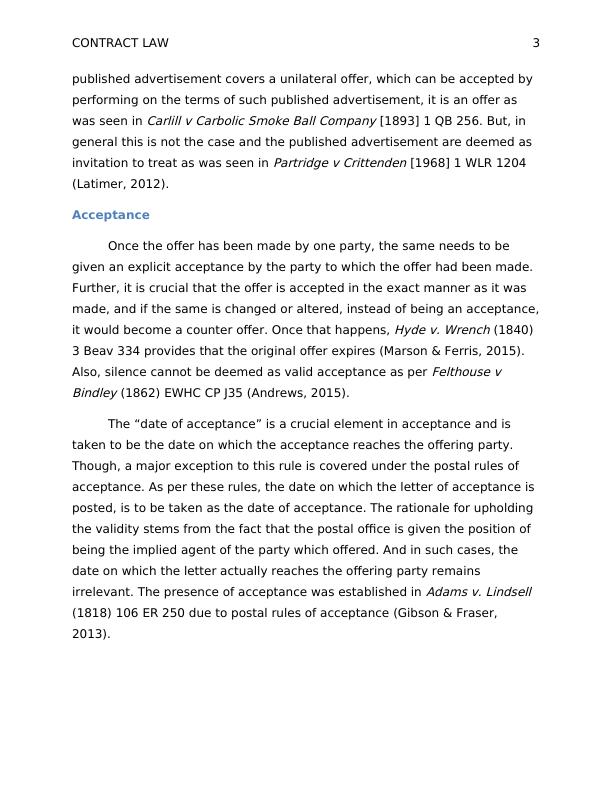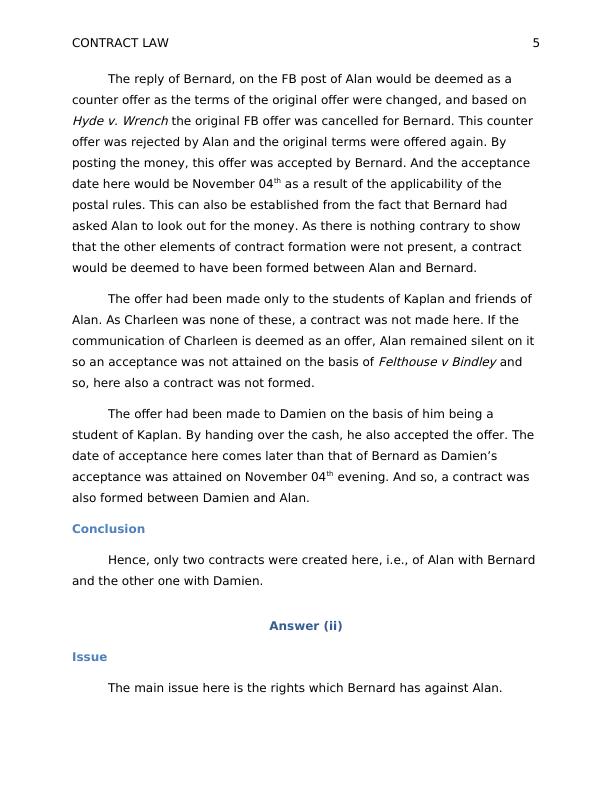Contract and Commercial Law Assignment
Added on 2020-03-16
10 Pages2608 Words32 Views
Commercial Law
Contract Law
(Student Details: )
01-Oct-17
Contract Law
(Student Details: )
01-Oct-17

CONTRACT LAW 2
Introduction
Contract can be defined as a promise undertaken in which one side of
the party promises to pay the consideration and in exchange of this the
other party undertakes the task which has been promised under the
contract. For creating any contract, there is a need to establish the existence
of certain elements and these include an offer, its acceptance, value of
consideration, capacity to contract, clarity of terms and the intention of
creating a contract. In case the promise made under the contract is not
fulfilled, a breach of contract occurs (Mulcahy, 2008). When such happens,
the parties could opt for litigation, or solve the dispute through Alternative
Dispute Redressal (ADR) methods. In the upcoming segments, the discussion
has been carried on these very issues.
Answer (i)
Issue
In this case, the main issue is whether a contract had been rightly
created in this case and where it was, between which particular parties was
it done.
Rule
Invitation to Treat and Offer
The very first requirement in forming the contract is an offer, in which
one party has to offer the other party some terms. It is important that a
differentiation has been made between an offer and an undertaken invitation
to treat. Invitation to treat shows that the parties want to initiate the
negotiations, whereas the offer shows that the parties want to create lawful
relationship (Roach, 2016). The differentiation between the two can become
important when it comes to the published advertisements. Where the
Introduction
Contract can be defined as a promise undertaken in which one side of
the party promises to pay the consideration and in exchange of this the
other party undertakes the task which has been promised under the
contract. For creating any contract, there is a need to establish the existence
of certain elements and these include an offer, its acceptance, value of
consideration, capacity to contract, clarity of terms and the intention of
creating a contract. In case the promise made under the contract is not
fulfilled, a breach of contract occurs (Mulcahy, 2008). When such happens,
the parties could opt for litigation, or solve the dispute through Alternative
Dispute Redressal (ADR) methods. In the upcoming segments, the discussion
has been carried on these very issues.
Answer (i)
Issue
In this case, the main issue is whether a contract had been rightly
created in this case and where it was, between which particular parties was
it done.
Rule
Invitation to Treat and Offer
The very first requirement in forming the contract is an offer, in which
one party has to offer the other party some terms. It is important that a
differentiation has been made between an offer and an undertaken invitation
to treat. Invitation to treat shows that the parties want to initiate the
negotiations, whereas the offer shows that the parties want to create lawful
relationship (Roach, 2016). The differentiation between the two can become
important when it comes to the published advertisements. Where the

CONTRACT LAW 3
published advertisement covers a unilateral offer, which can be accepted by
performing on the terms of such published advertisement, it is an offer as
was seen in
Carlill v Carbolic Smoke Ball Company [1893] 1 QB 256. But, in
general this is not the case and the published advertisement are deemed as
invitation to treat as was seen in
Partridge v Crittenden [1968] 1 WLR 1204
(Latimer, 2012).
Acceptance
Once the offer has been made by one party, the same needs to be
given an explicit acceptance by the party to which the offer had been made.
Further, it is crucial that the offer is accepted in the exact manner as it was
made, and if the same is changed or altered, instead of being an acceptance,
it would become a counter offer. Once that happens,
Hyde v. Wrench (1840)
3 Beav 334 provides that the original offer expires (Marson & Ferris, 2015).
Also, silence cannot be deemed as valid acceptance as per
Felthouse v
Bindley (1862) EWHC CP J35 (Andrews, 2015).
The “date of acceptance” is a crucial element in acceptance and is
taken to be the date on which the acceptance reaches the offering party.
Though, a major exception to this rule is covered under the postal rules of
acceptance. As per these rules, the date on which the letter of acceptance is
posted, is to be taken as the date of acceptance. The rationale for upholding
the validity stems from the fact that the postal office is given the position of
being the implied agent of the party which offered. And in such cases, the
date on which the letter actually reaches the offering party remains
irrelevant. The presence of acceptance was established in
Adams v. Lindsell
(1818) 106 ER 250 due to postal rules of acceptance (Gibson & Fraser,
2013).
published advertisement covers a unilateral offer, which can be accepted by
performing on the terms of such published advertisement, it is an offer as
was seen in
Carlill v Carbolic Smoke Ball Company [1893] 1 QB 256. But, in
general this is not the case and the published advertisement are deemed as
invitation to treat as was seen in
Partridge v Crittenden [1968] 1 WLR 1204
(Latimer, 2012).
Acceptance
Once the offer has been made by one party, the same needs to be
given an explicit acceptance by the party to which the offer had been made.
Further, it is crucial that the offer is accepted in the exact manner as it was
made, and if the same is changed or altered, instead of being an acceptance,
it would become a counter offer. Once that happens,
Hyde v. Wrench (1840)
3 Beav 334 provides that the original offer expires (Marson & Ferris, 2015).
Also, silence cannot be deemed as valid acceptance as per
Felthouse v
Bindley (1862) EWHC CP J35 (Andrews, 2015).
The “date of acceptance” is a crucial element in acceptance and is
taken to be the date on which the acceptance reaches the offering party.
Though, a major exception to this rule is covered under the postal rules of
acceptance. As per these rules, the date on which the letter of acceptance is
posted, is to be taken as the date of acceptance. The rationale for upholding
the validity stems from the fact that the postal office is given the position of
being the implied agent of the party which offered. And in such cases, the
date on which the letter actually reaches the offering party remains
irrelevant. The presence of acceptance was established in
Adams v. Lindsell
(1818) 106 ER 250 due to postal rules of acceptance (Gibson & Fraser,
2013).

End of preview
Want to access all the pages? Upload your documents or become a member.
Related Documents
Assignment on Commercial Law and Contract Lawlg...
|11
|2733
|214
Introduction to The Commercial Lawlg...
|9
|2643
|14
Case Study on Commercial Law Assignmentlg...
|11
|2850
|213
Business Law Group Assignmentlg...
|15
|2499
|339
Commercial Law Assignmentlg...
|12
|2839
|82
TLAW101 - Business Law Assignmentlg...
|9
|2035
|39
